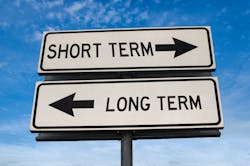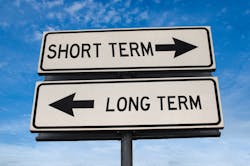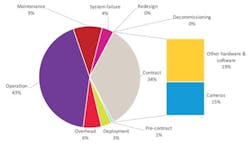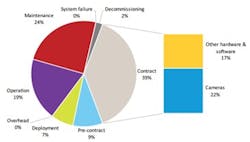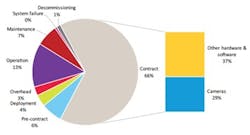How to Stay Focused on the Long-Term in a Short-Term Technology Investment World
TCO and ROI are well-established concepts for strategic buyers to use when comparing bids from different technology providers. TCO can help you contrast costs for procurement, deployment, operation, and risk between systems. By weighing TCO against a system’s estimated value, you can determine which solution will deliver the best ROI for you during its expected lifespan.
What constitutes the TCO
When looking at TCO, it’s helpful to think of costs as falling into three major categories: acquisition, operation, and decommissioning. The specific costs within these categories tend to vary depending on the individual customer and the system being deployed.
Consider the following as a suggested guideline for identifying cost factors that might be relevant to the proposals you’re evaluating.
CHART
Factoring in the cost of risk
While risk is a harder cost to quantify, you should still include it as part of your TCO assessment and buying decision. Some of the key risk areas you might consider are:
- Risk of losing critical data. If you use a camera system for loss prevention or transaction verification, what are the projected costs if the system goes down?
- Risk of a cyberattack. What would be the business impact if your system is attacked and service is compromised? Would you lose data or customer trust?
- The risk to your brand. How would your brand be impacted if your system supplier doesn’t meet sustainability standards, whether environmental, social, economic, or ethical business practices?
Five steps to getting started with TCO
With everything I’ve thrown at you so far, using TCO to qualify the right technology provider might seem overwhelming. But it doesn’t have to be. Start small. Choose factors you can readily quantify and that you believe are most important to your operation. You can always add to that list over time.
I’d suggest beginning with these five steps:
1. Scrutinize the price. Be sure you know what’s really included. Do you have to pay extra for mounting accessories or is the product out-of-the-box ready? What about specialized cabling or weather-proof housing? Do you need to purchase additional lighting or is the camera sufficiently light-sensitive to manage without it?
2. Look at key deployment factors. How easy or difficult is it to install the system? Will services be disrupted during installation? Will you have to modify the site? How easy will it be to integrate with your other systems? How much training will your staff need?
3. Look at key operation factors. How much time will you spend on maintenance? What are typical failure rates? Will the solution increase costs in other parts of the ecosystem – network storage, bandwidth requirements, power consumption, etc.?
4. Look at “hidden” costs. How easy will it be to change, adapt, or expand your system in the future? Is there freight or warehouse costs involved in the purchase? What about licensing and service fees? Will the solution require more staff to spend time using the system or will it enable you to automate certain tasks?
5. Look at risk costs. What are the key risks associated with using this system? What are the key risks associated with connecting this system to the network or integrating it with other security systems?
Unpacking the best value proposition
Once you have a solid TCO calculation you can use it as the basis for estimating the lifetime value of the system, in other words, its ROI. In the security industry that value might include reducing theft and vandalism, increasing the safety of people and property, enhancing the customer experience, or improving business practices and processes. The important thing is to identify which values – some of which might be intangible – are most important to you. Start by mapping the challenges and possible opportunities you face. Talk with industry peers to expand your perspective on what’s possible.
Also, ask competing technology providers to help you quantify those values. They should be able to project the typical outcomes and value you can expect to receive from their systems. Challenge them to provide a good value argument with their proposal, including case studies and testimonials from other customers who have implemented similar solutions.
How to determine a system’s potential value
Several factors go into defining a system’s potential value. You need to look at:
o Can you use the cameras, speakers and other IP technology to help you comply with COVID-19 health guidelines – reminding people to wear masks, use sanitizer and maintain social distance – so you can remain open and stay in business?
o Can you share business intelligence with other departments like marketing, merchandising, and facilities management to improve revenue and identify ways to reduce operating costs?
o Could manufacturing use the security video to train line workers on safety protocols and identify ways to minimize production bottlenecks?
o Could the warehouse use the security video to improve logistics and inventory control?
o In a healthcare setting, could cameras and audio analytics integrate with telemetry systems for remote patient monitoring, helping to stretch staffing resources, limit face-to-face contact and the potential for exposure/contamination while still delivering high-quality patient care?
o In retail, can stores use cameras integrated with sensors, analytics, and audio to drive traffic to promotional displays or notify staff of long check lines so the retailer can improve customer service. Can video analytics help management identify peak hours when additional staff would be needed and less busy times when cleaning and restocking would be less obtrusive to customers?
Once you start thinking outside the box, you’ll realize the exponential value and ROI you can achieve when you share your technology investment with other areas of your business.
Three real-world examples of TCO-ROI analysis
To help you better understand how all these elements come together, let’s look at how three real-world customers determined the long-term cost of their video surveillance system and the lifetime value it created.
- Municipalidad de Vincente López: a smart city installation
The government of Vincente López, a municipality in the great Buenos Aires area of Argentina, wanted to deploy a large video surveillance solution to create a more secure environment for its citizens. They conducted a TCO analysis of a 1500-camera proposal based on an expected 10-year lifespan of the technology. The analysis revealed a TCO of around USD 29 million. About 34% of the cost was attributed to acquisition: investments in hardware and software. The remaining 66% would occur during installation, operation, and maintenance.
Their TCO cost distribution looked like this:In calculating their TCO, the municipality chose not to take some cost factors into accounts such as the cost for alarm failures and costs incurred in business operations due to system downtime. They also chose to set their decommissioning costs to zero. They also looked at adding video compression technology to the project. This would lower bandwidth consumption and storage needs, reducing TCO by USD 450,000 or around USD 300 per camera.
While quantifying the exact ROI is difficult in a smart city installation, the municipality looked at benefits such as faster emergency response time, smoother traffic flow, and an overall improvement in safety and security. One additional benefit they noted was that the analysis helped city managers better forecast system costs. They could now engage in concrete, constructive dialog with decision-makers regarding budgeting and future expansion of the system.
- The Christie Lodge: a hotel installation
The Christie Lodge, a hotel property in the Colorado Rocky Mountain area, decided to deploy a 40-camera surveillance system to protect its guests and staff. Based on a seven-year lifespan, the customer estimated the TCO for the system would be $91,000. About 54% of the TCO was attributed to acquisition costs related to planning, equipment purchase, installation, and staff training. About 44% of the TCO was attributed to operation costs, maintenance, and failures. And around 2% of the TCO was estimated as final decommissioning costs for the system.
Their TCO cost distribution looked like this.The Christie Lodge was able to identify numerous benefits it experienced from its surveillance system. The video had been used to resolve guest complaints, investigate car accidents, and even provide forensic evidence to law enforcement about burglaries committed at bordering properties. The main savings, however, came from two sources: reducing the need for rented security staff and refuting fraudulent liability claims.
The hotel estimates that they save around $40,000 to $50,00 a year with this new system. This means that the investment essentially paid for itself by the end of its second year of operation. By the end of year seven, the projected ROI will exceed 257%.
- RC Willey: a retail chain installation
RC Willey, a retail home furnishings chain in the western United States, wanted to deploy an enterprise video surveillance system with 800 cameras installed in its retail stores and distribution centers. Based on a 7-year lifespan, the customer estimated the TCO for the system would be $1.39 million. About 76% of TCO would occur during the acquisition phase with planning, equipment purchases, installation, and training. About 23% of TCO would be allocated to operations, maintenance, and outages. And the remaining 1% was allocated to decommissioning costs.
Their TCO cost distribution looked like this:RC Willey calculated that it cost slightly more the $46,000 a year to run the system. But that cost was more than offset by the enormous reduction in shrink from having high-quality surveillance cameras tracking inventory. According to the company, before the system was installed the company was losing millions of dollars a year to shrinking. Thanks in large part to the cameras, shrinkage is down to about 0.01%, which is 170% below the industry average of 1.7%.
The camera system also helps RC Willey mitigate slip-and-falls and other litigation claims, some of which could run as high as $100,000. With forensic video, they’re able to refute false claims and reach fairer settlements for legitimate claims.
Overall, RC Willey estimates the yearly savings from the camera system to be around $5.7 million. This means that the company recouped the cost of the system in the first year of operation and the final ROI at the end of seven years will be more than 2,768%.
The Importance of Bringing TCO and ROI into Your Buying Decisions
As you can see, TCO and ROI analyses not only help you calculate the true cost of a planned system but also estimate the value that the system could deliver over its lifetime. Including TCO and ROI perspectives in your buying process will help you evaluate competing offers more reliably and choose the most cost-effective solution that will bring you the best long-term value.
About the author: Scott Dunn is the Senior Director of Business Development Solutions and Services for Axis Communications, Inc.
About the Author
Scott Dunn
Scott Dunn is the Director of Business Development for Axis Communications (www.securityinfowatch.com/10212966). He has spent nearly 20 years in the access control and video manufacturing industries.
